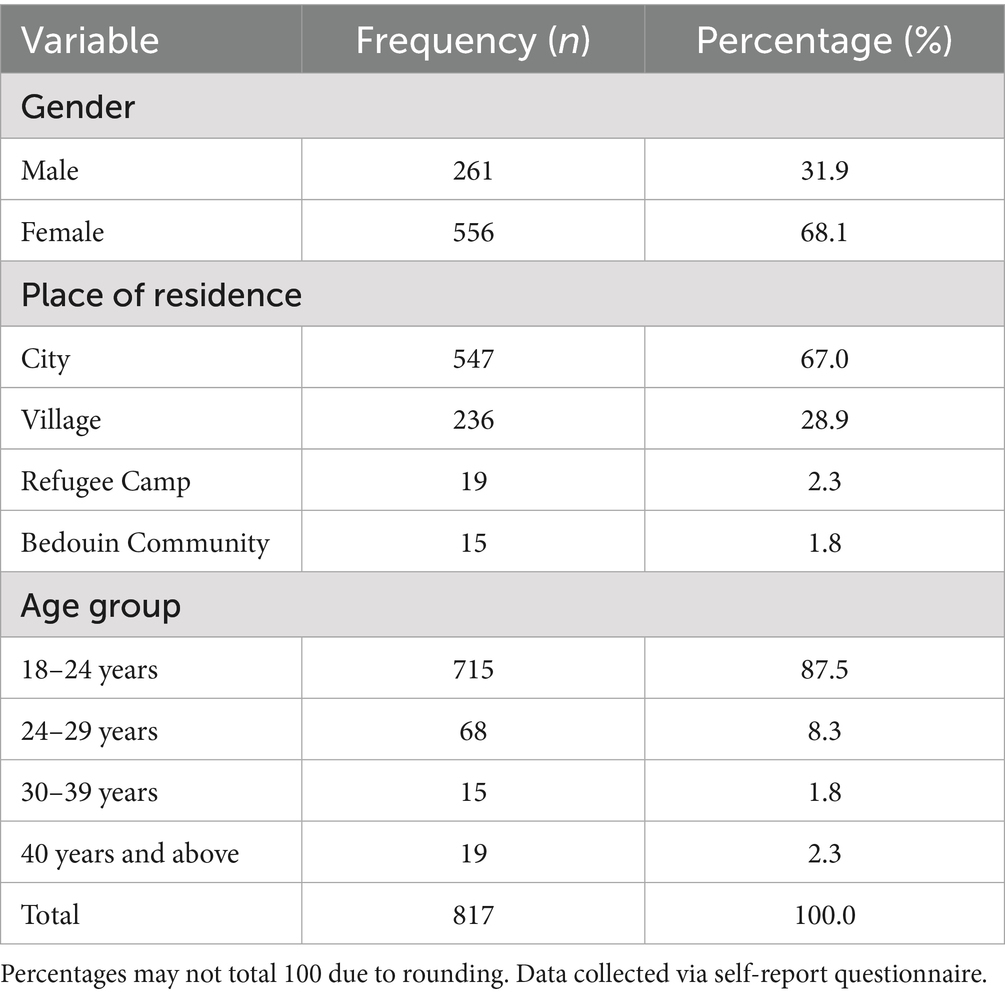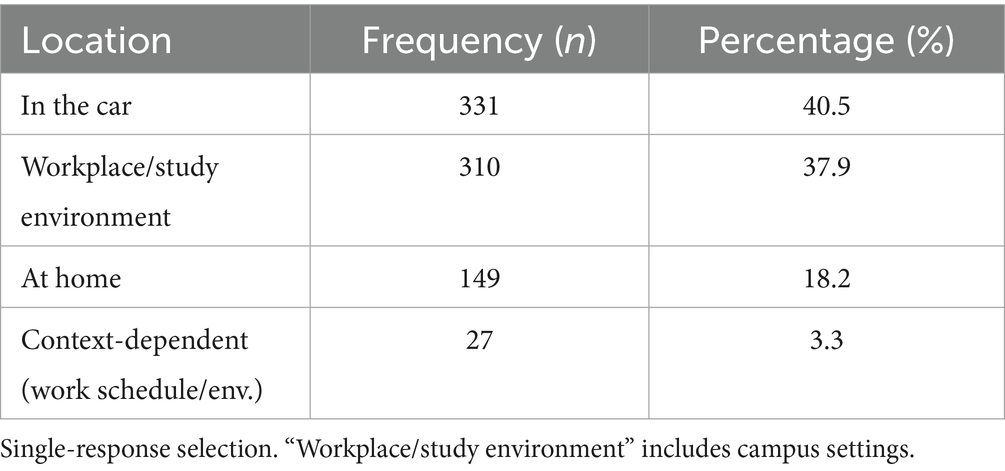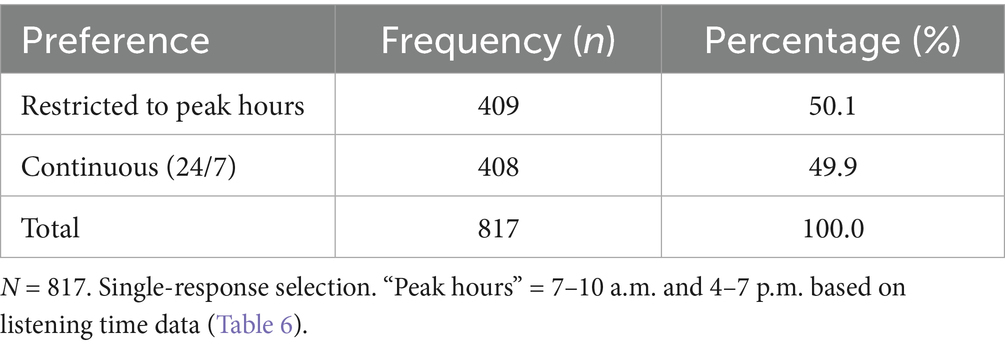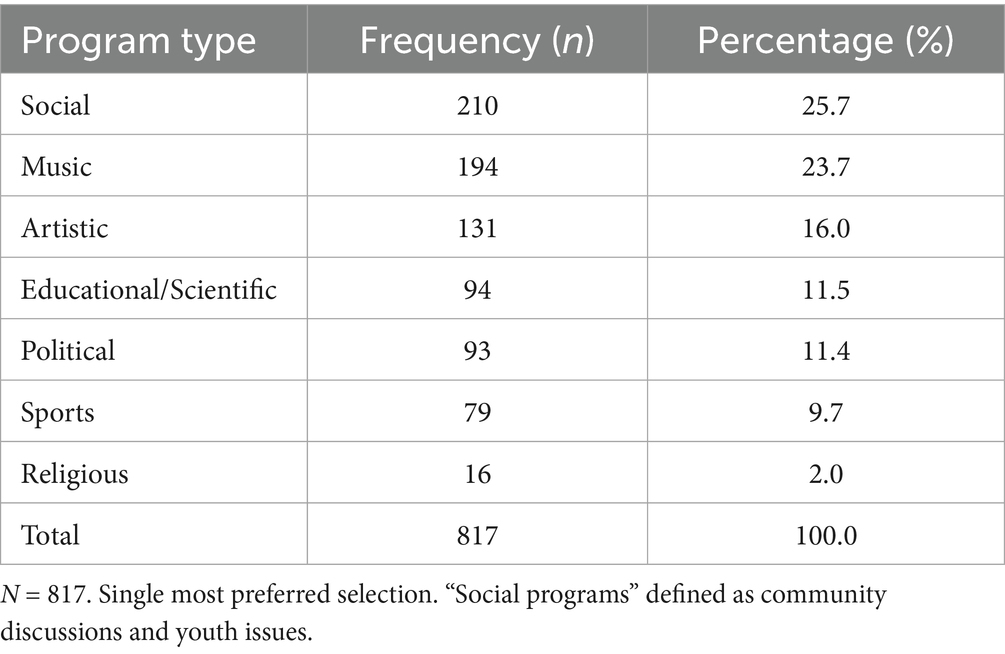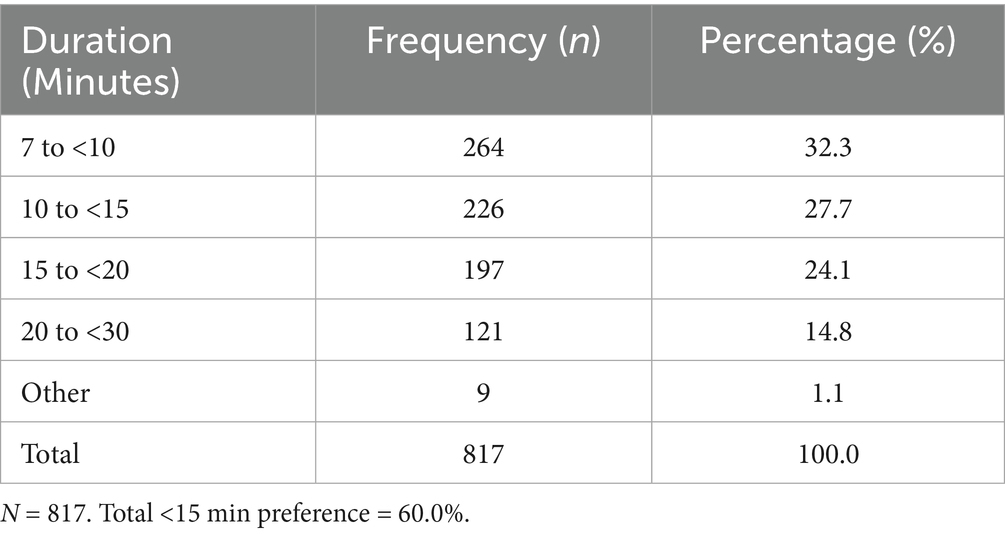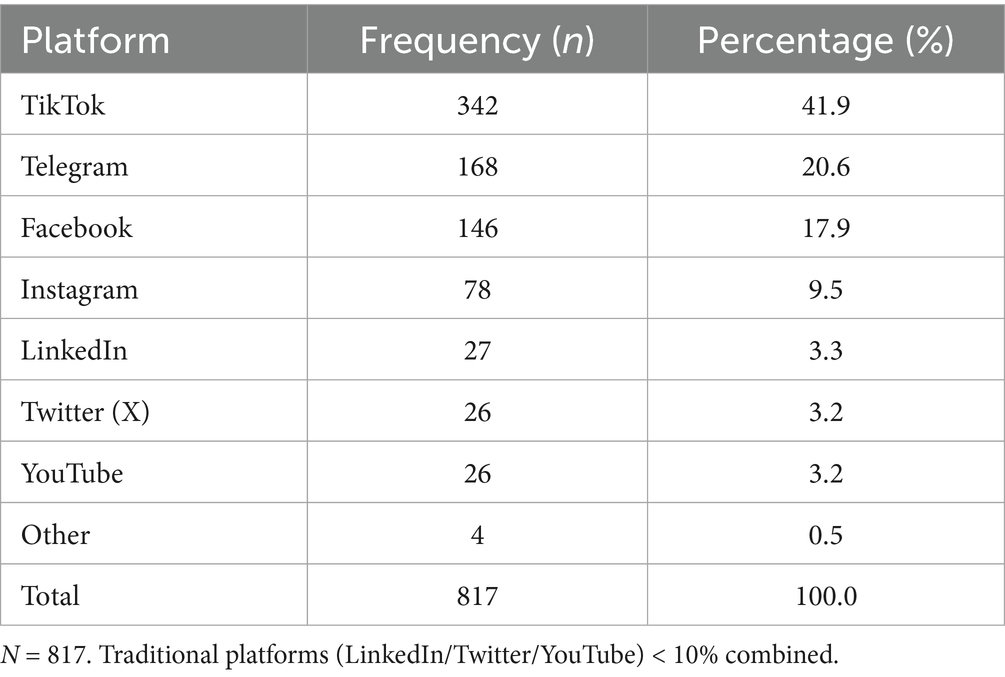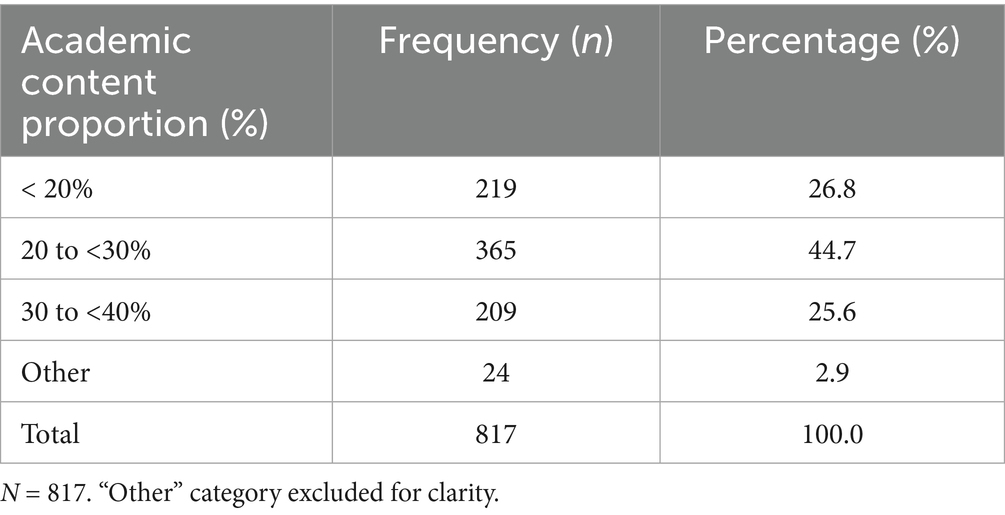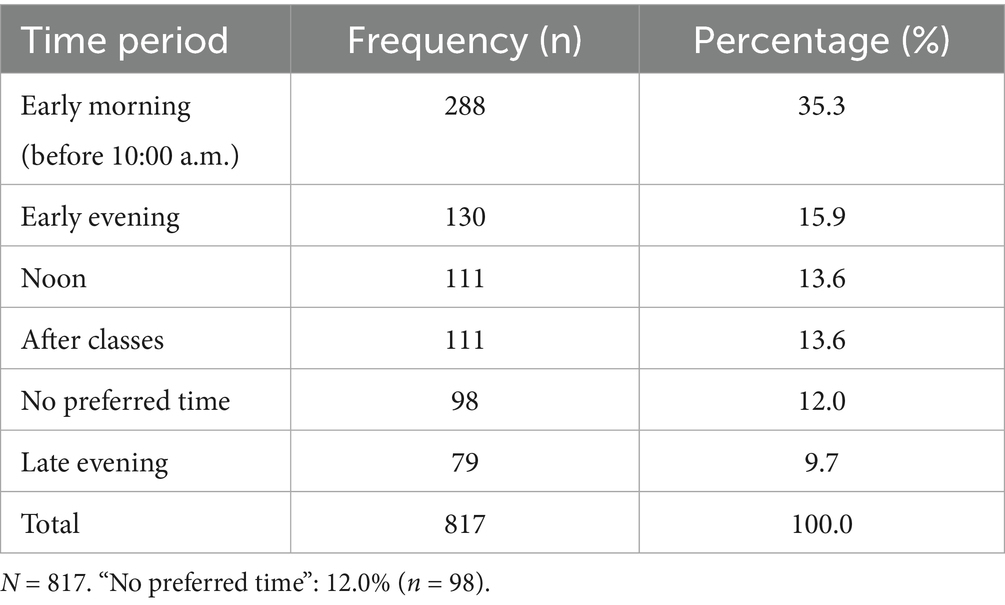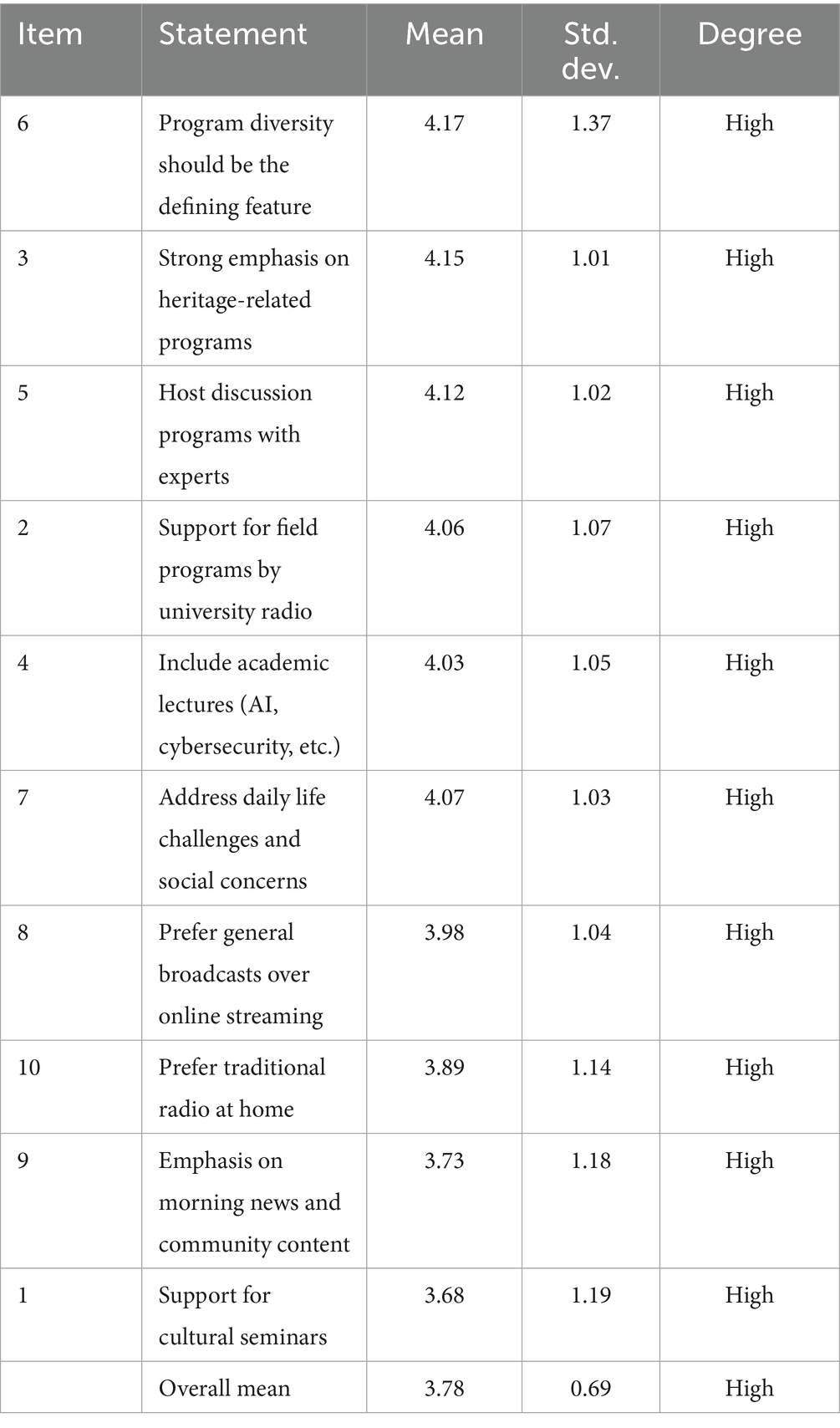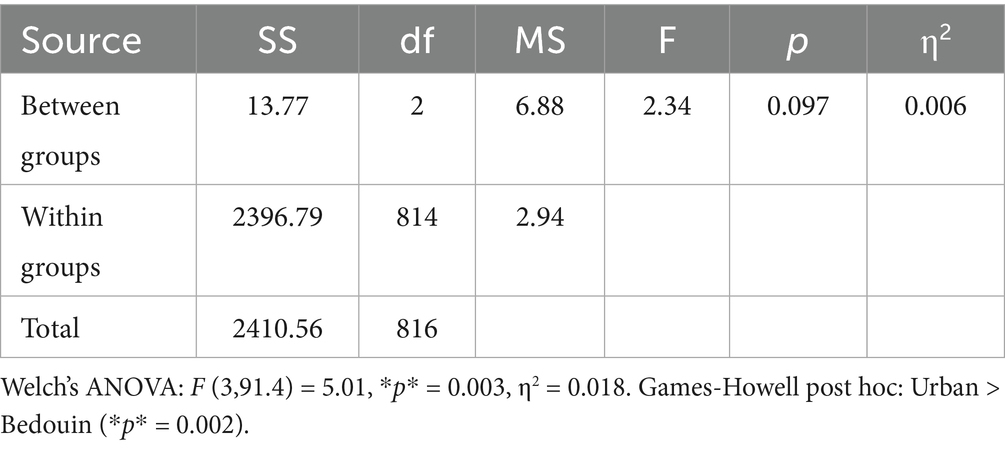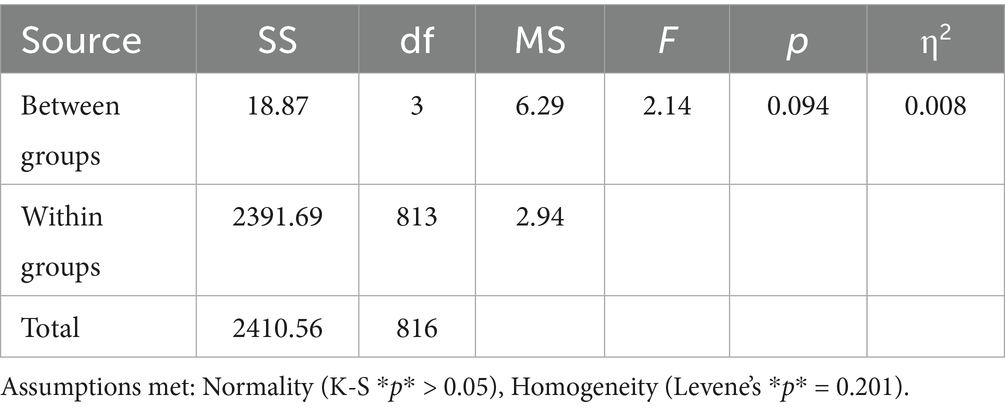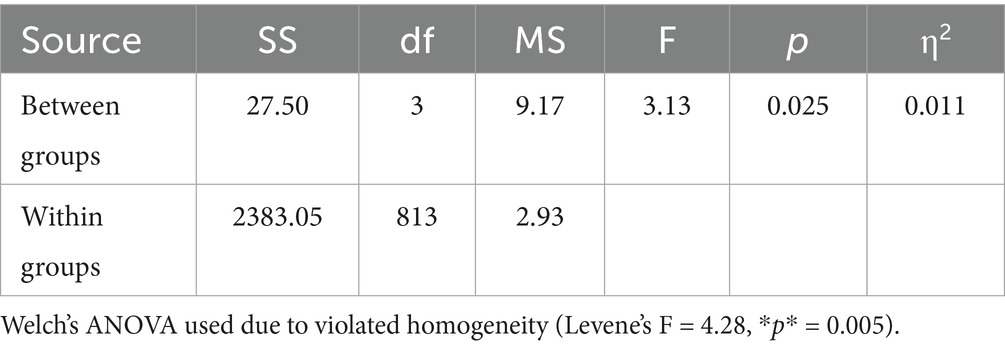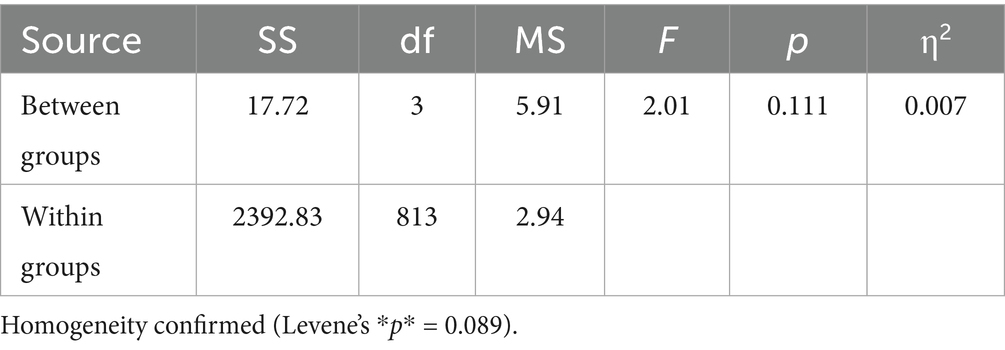- 1Arabic Language and Media Department, Faculty of Arts and Education, Arab American University-Palestine, Jenin, Palestine
- 2Radio and Television Department, Arab American University, Jenin, Palestine
Introduction: University radio plays a vital pedagogical and civic engagement role in higher education; however, its alignment with digital-native media behaviors remains underexplored, particularly in the Global South. This study examines undergraduate engagement with university radio in Jordan, focusing on content preferences, access disparities, and institutional broadcasting constraints.
Methods: A convergent mixed-methods design was employed, integrating quantitative survey responses from 983 students across three public universities with qualitative interviews from four university radio directors. Although 983 students were initially surveyed, the final analysis was based on 817 valid and analyzable questionnaires. Quantitative data were analyzed using descriptive statistics, t-tests, ANOVA, and effect size estimates (Cohen’s d, η²), while qualitative transcripts were thematically coded following Braun and Clarke’s framework with inter-coder reliability (κ = 0.78).
Results: Findings revealed a strong preference among students for socially oriented, short-form content delivered via digital platforms, with 60% favoring programs under 15 min and 41.9% preferring TikTok. In contrast, directors emphasized traditional FM broadcasting and heritage-driven, state-aligned programming. Significant geographic disparities emerged, with Bedouin students reporting lower engagement levels than their urban peers (ΔM = 1.10, p = 0.003). High satisfaction scores for heritage content (M = 4.15) masked gaps in production capacity due to reliance on volunteer labor.
Discussion: The results underscore a critical misalignment between institutional media practices and student digital consumption patterns, highlighting the need for hybrid, student-led content strategies and targeted infrastructure investments to promote equity and relevance in university broadcasting.
1 Introduction
University radio has long played a pivotal role in higher education institutions worldwide, serving as a bridge between academia and the broader community. These media platforms not only disseminate educational content but also foster student creativity, civic engagement, and institutional identity. Globally, the landscape of radio broadcasting is evolving under the pressure of digital transformation, the proliferation of streaming platforms, and shifting media consumption habits among younger audiences. Within this dynamic environment, understanding how university students interact with, and value university radio has become increasingly important for educators, media planners, and institutional decision-makers.
In Jordan, university radio has emerged as a significant component of campus life and academic communication. Since the early 2000s, several universities most notably Jordan University, Yarmouk University, and Mutah University have established radio stations as part of their communication and media departments. These stations aim to deliver educational, cultural, and community-oriented content while serving as a training ground for students pursuing media and communication studies. However, with the growing dominance of digital media, podcasts, and social platforms, questions have arisen about the relevance, accessibility, and appeal of traditional university radio to contemporary students. As Jordanian higher education institutions increasingly seek to integrate media into pedagogical and institutional strategies, assessing student preferences and satisfaction with university radio content becomes vital.
Several global and regional studies have explored university radio as a platform for student expression and public engagement. Research grounded in Uses and Gratifications Theory (UGT) posits that audiences actively seek media that fulfill specific informational, entertainment, and social needs (Ayyad, 2011; Damani and Mitchell, 2020). University radio must therefore compete with a range of digital alternatives by offering content that aligns with student preferences. Similarly, Media Ecology Theory suggests that changes in communication technology reshape not only how we communicate but also the institutional functions of media (Reelfs et al., 2022). As university radio transitions into digital spaces, it must adapt to new listening habits, particularly among digital-native students. Studies grounded in Public Sphere Theory also frame university radio as a form of participatory media that can facilitate democratic dialog and social inclusion (Habermas, 1989).
Empirical research highlights both opportunities and challenges in this domain. For example, in Turkey, (Tufan et al., 2021) examined the content structures of university radio and noted a shift toward entertainment content and declining student engagement with academic programming. However, in Jordan, empirical data on this issue remains sparse. Al Subaihi and Sawalha (2023) explored news consumption among Jordanian university students and found high engagement with digital news but minimal use of institutional media platforms such as university radio.
This research gap is especially significant given the strategic role of university media in Jordan’s national education strategy and youth development agenda. Although universities like Yarmouk and Mutah have modernized their media infrastructure, the extent to which these efforts resonate with student audiences remains unclear. Moreover, there is limited understanding of how university radios in Jordan manage “media balance” a term used in this study to denote the ratio of academic-to-entertainment content broadcasted and its perceived appropriateness by student audiences. Existing studies either focus on general media consumption among youth or overlook university radio as a distinct institutional medium. Thus, this study aims to fill both empirical and theoretical gaps by providing a nuanced analysis of student preferences and the effectiveness of university radio content.
The significance of this research lies in its dual academic and practical contributions. Academically, it enriches literature on audience-centered media planning in higher education, with a specific focus on the Middle East and North Africa (MENA) region. Theoretically, it draws from UGT, Media Ecology, and Public Sphere frameworks to explore how media preferences and institutional strategies intersect. Practically, the findings offer actionable insights for university administrators, content producers, and policymakers to enhance programming, improve digital integration, and align media output with student needs.
The primary aim of this study is to assess the acceptance level of Jordanian university students toward university radio programs, with a specific focus on content types, broadcast formats, preferred engagement times, and digital dissemination platforms. By examining three prominent university radio stations Jordan University Radio, Yarmouk University Radio, and Mutah University Radio the study seeks to generate actionable insights for enhancing the appeal and utility of university radio in Jordan.
1.1 Research objectives
1. Identify the types of programs students prefer on university radios.
2. Determine the proportion of academic programs preferred by respondents and assess their perceived relevance in the context of educational media.
3. Clarify the types and formats of radio content most appealing to Jordanian university students.
4. Identify optimal broadcast times for radio programs from the perspective of Jordanian university students.
5. Understand the most preferred times for students to engage with university radio content.
6. Identify preferred digital platforms for following university radio broadcasts.
1.2 Research questions
1. What types of programs do respondents prefer on university radios?
2. What proportion of academic content do respondents find suitable on university radios?
3. What are the most appealing radio formats for Jordanian university students?
4. What are the optimal broadcast times according to Jordanian university students?
5. What times do Jordanian university students prefer most for engaging with various types of educational radio content?
6. What digital platforms do respondents prefer for accessing university radio broadcasts?
This study is situated within the interdisciplinary fields of Communication Studies, Media Studies, and Educational Technology, offering an integrative framework to examine the role of university media in student life. It draws from media theory, youth studies, and educational policy to provide insights into how institutional media can adapt to evolving student needs in a digital era.
By mapping the current landscape of university radio engagement in Jordan and evaluating the preferences of its primary audience, this research addresses a previously underexplored area and contributes a regionally grounded perspective to global discussions on educational media reform and youth participation.
2 Literature review
Radio broadcasting has undergone a profound transformation with the advent of digital technologies, which have reshaped how content is produced, distributed, and consumed. The resilience of radio lies in its adaptive integration of emerging technologies, audience engagement strategies, and its evolving institutional role within educational environments, particularly in university contexts. A systemic overview by Cerdá Suárez et al. (2021) emphasizes that digital transformation in higher education is both a technological and institutional reconfiguration highly relevant for understanding university radio’s trajectory.
One of the most significant developments has been the integration of digital platforms such as podcasts, social media, and mobile applications. These tools have enhanced radio’s interactivity and multimedia capabilities, making it more accessible and engaging for contemporary audiences (Mostefaoui, 2019). Furthermore, advancements in satellite and internet broadcasting have significantly improved signal quality and extended geographic reach (Petrova and Kislova, 2020). Despite these technological strides, challenges persist, especially in regions like Jordan and Algeria where infrastructure limitations, inadequate funding, and insufficient training hinder the adoption of digital broadcasting technologies (Suyanto et al., 2022).
In a case study from the Philippines, Villaester (2025) illustrates how digital adaptation allowed a traditional university radio station to re-emerge as a participatory, student-driven platform highlighting both technical and organizational resilience. Similarly, Tick and Lin (2025) demonstrate that the integration of digital platforms significantly boosts student engagement and learning outcomes, aligning well with how university radio might evolve toward hybrid educational-entertainment formats.
The digitization of radio has brought about a trade-off between credibility and accessibility. While real-time engagement and perceived credibility have improved, the traditional auditory identity of radio is increasingly at risk. The medium is beginning to mirror visual-centric platforms, thereby diluting its unique characteristics (Suyanto et al., 2022). To understand these shifts, Media Ecology Theory offers a valuable framework. It emphasizes how media technologies reconfigure institutional communication ecosystems and user relationships, necessitating strategic transformations to ensure relevance in the digital age (Reelfs et al., 2022).
University radio stations represent a distinct blend of educational and community-oriented media. They aim to educate while simultaneously engaging a diverse audience. However, tensions often arise between these dual objectives. For example, in Turkey, university radios have been criticized for prioritizing entertainment content over educational programming (Tufan et al., 2021). In contrast, Nigerian stations focus on knowledge dissemination but struggle with audience analytics, which hampers their ability to retain and target listeners effectively (Acheme and Adesemoye, 2022; Muringa and Adjin-Tettey, 2024).
This issue is echoed in Kenyan research, where Awiti and Ong’ong’a (2024) found that university students favor online radio platforms but often perceive institutional content as outdated or irrelevant. Complementarily, Safar and Alkhezzi (2016) discovered that students in Kuwait value streaming media for its immediacy and personalization both crucial for youth-centered educational strategies.
Listener motivations further complicate programming strategies. Across regions, audiences are primarily driven by information-seeking behavior. In Arab contexts, radio content often revolves around religious, political, and social themes, which reflects broader cultural and societal interests (Farah, 2020). However, university radio operations are constrained by structural limitations, including reliance on student volunteers, rigid academic schedules, and institutional curfews that limit broadcasting times (Villaester, 2025; Usman, 2020).
The Uses and Gratifications Theory provides insight into these dynamics by explaining how students engage with radio content that meets their informational and social needs (Ayyad, 2011). Simultaneously, Habermas’s Public Sphere Theory positions university radios as potential enablers of public discourse. Yet, this role is often compromised by administrative censorship and limited content autonomy (Tufan et al., 2021).
Another overlooked factor is how radio fits within newer digital ecosystems. Wang and Wu (2019) argue that digital-native users expect rapid feedback, interactive features, and algorithmic personalization traits that FM broadcasting largely lacks. These shifts necessitate institutional reforms in how radio is produced and consumed.
In the Jordanian context, university radio stations such as those at Jordan, Yarmouk, and Mutah universities align with national priorities like youth empowerment and education (Suyanto et al., 2022). Nevertheless, existing literature in this area remains narrowly focused, often exploring political or religious outcomes without addressing broader questions of audience engagement, content diversity, or digital platform usage (Farah, 2020). Moreover, there is a conspicuous lack of empirical studies examining how students interact with emerging digital radio formats and how these interactions influence their perceptions of educational content.
In the Jordanian and wider MENA context, recent scholarship has begun to explore the interplay between digital media, students, and higher education. Indeed, Mohd and Puche (2025) demonstrates how university students in Jordan are increasingly shifting their news and media consumption toward digital platforms, revealing changing media repertoires that bypass traditional institutional outlets. In parallel, TikTok has emerged as a central venue for youth engagement in informal learning and identity formation: Omar and Wang (2020) show how its participatory, mobile-first design strongly appeals to students’ motivations for creativity and connection. Incorporating these insights contextualizes the strong TikTok preference observed in this study and situates it within regional debates on digital-native media behavior and educational media innovation.
Methodologically, many prior studies rely on descriptive research designs and overlook the benefits of mixed-methods approaches. This results in a limited understanding of how to effectively balance academic content with entertainment to maximize student engagement. A synthesis of existing theoretical perspectives Media Ecology and Uses and Gratifications alongside an awareness of institutional constraints underscores the need for focused research into how university radios in Jordan can evolve to fulfill both student expectations and institutional mandates. An early doctoral study Miller (2017) emphasized that podcasts and mobile platforms were already forcing organizational restructuring in campus stations a process that is only accelerating today.
The present study addresses these gaps by offering a comprehensive examination of student preferences in university radio. The research applies both Media Ecology and Uses and Gratifications Theory to understand media adaptation in a digital age. Empirical data will shed light on preferred content types, listening habits, and platform choices among students from multiple Jordanian universities. The findings aim to inform practical strategies for content development, scheduling, and technological integration, thus aligning university radio programming with contemporary student media habits and institutional goals.
3 Methodology
3.1 Research design
This study employs a convergent parallel mixed-methods design, integrating quantitative student surveys with qualitative semi-structured interviews of university radio directors. This approach was chosen to enable simultaneous collection and comparison of student preferences and institutional constraints, facilitating real-time triangulation of contradictions in university radio engagement (Fetters et al., 2013; Wimmer and Dominick, 2013).
3.2 Setting
The research was conducted at three geographically diverse public universities in Jordan: the University of Jordan (Central), Yarmouk University (North), and Mutah University (South), which collectively serve over 60,000 undergraduate students. Data were collected from October 6–14, 2024, during a period of increasing digital media integration in Jordanian higher education.
3.3 Population and sampling
The target population primarily comprised full-time undergraduate students aged 18–26, with particular emphasis placed on those pursuing a first university degree. While graduate and part-time students were not explicitly excluded, the sampling strategy concentrated on full-time undergraduate participants. A stratified random sampling method was employed, based on both academic faculty and regional representation (urban, rural, and Bedouin), to ensure proportional diversity. The final sample of 983 students allows for generalizability at a 95% confidence level with a ± 5% margin of error. However, more than half of the respondents were drawn from the University of Jordan (51.7%), which may introduce an institutional concentration effect. Although stratification was applied to balance faculty and regional representation, the dominance of one university should be considered when interpreting the representativeness of results across the entire system.
Qualitative data were gathered through interviews with four university radio directors, purposively selected based on their administrative roles overseeing licensed university radio platforms. Saturation was reached when no new themes emerged.
3.4 Instruments
The quantitative tool was a 25-item structured questionnaire using 5-point Likert scales to measure students’ content preferences, platform use, program duration preferences, satisfaction levels, and perceptions of university radio effectiveness. Among these items, ‘hybrid presenter models’ were defined as formats in which academic experts and professional broadcasters jointly deliver content, a configuration tested in the survey for its appeal to students. The instrument was pilot-tested with 30 students for clarity. Expert content validation (n = 3 media scholars) yielded Aiken’s V > 0.80. Internal consistency reliability was high (Cronbach’s α = 0.843). While content validity was established through expert review, construct validity beyond expert judgment was not fully assessed in this study. Future research should employ confirmatory factor analysis (CFA) or similar approaches to strengthen evidence of construct validity.
The qualitative component used an 8-question semi-structured interview protocol piloted with two directors. Questions focused on institutional practices, content balance, technological limitations, and perceived audience engagement. Ambiguities were revised post-pilot.
3.5 Procedures
The surveys were administered through field-based data collection. Distribution was conducted independently of faculty involvement to minimize potential bias. A probabilistic sampling approach was carefully implemented to ensure equal representation opportunities across the target population, thereby reducing sampling bias. Participation remained entirely voluntary and anonymous. Interviews were conducted in quiet office settings, via Zoom or in person, with informed consent. Non-verbal cues were documented through video recordings. Transcripts were anonymized and assigned codes (e.g., R1, D1).
3.6 Data analysis
Quantitative data were analyzed using SPSS v28. Descriptive statistics (frequencies, percentages, means), independent samples t-tests, and one-way ANOVA were conducted to examine differences across demographics (gender, major, region). Assumptions of normality (Shapiro–Wilk) and homogeneity of variance (Levene’s) were tested. Effect sizes were reported (Cohen’s d, η2) with η2 = 0.018 interpreted as small practical significance (Richardson, 2011).
Qualitative analysis followed Braun and Clarke’s (2006) six-phase thematic framework. Transcripts were inductively coded by two researchers using NVivo 14. Inter-coder agreement (κ = 0.78) indicated substantial consistency. Themes were reviewed and refined through iterative peer debriefing and supported by illustrative quotes. An audit trail documented coding decisions.
3.7 Trustworthiness measures
Credibility was ensured through data triangulation, member checking with three directors, and reflexive journaling. Anonymity and independent distribution of surveys reduced social desirability bias. The study protocol was reviewed and approved by the Institutional Review Board (IRB) at Arab American University–Jenin. As the research involved minimal risk, informed consent was obtained electronically via Google Forms for surveys, where participants acknowledged agreement before proceeding, and through signed forms for director interviews. The study complies with the ethical principles outlined in the Declaration of Helsinki and adheres to national and institutional regulations governing research ethics in Palestine.
Key terminology used in this study includes the following definitions: Perspective refers to student evaluations of radio content, delivery, and overall effectiveness. University radios denote FM and digital broadcasting services operated by Jordanian public universities. Radio programs encompass the thematic content segments aired, such as academic, artistic, or social topics. Presentation methods describe the various broadcast formats utilized, including traditional FM radio, social media platforms, and podcasts. Finally, higher education institutions are defined as public universities officially accredited in Jordan.
3.8 Limitations
The director sample was limited to four, based on expert consultations during a pre-study focus group confirming their suitability as key informants. These individuals were purposively selected because they oversee the only licensed university radio stations in Jordan, and thematic saturation was reached, though findings should not be overgeneralized. Interviews were conducted face-to-face. Although stratified random sampling was applied, student surveys were distributed through fieldwork rather than online methods to enhance representativeness. Nevertheless, more than half of respondents were drawn from the University of Jordan (51.7%), which may introduce an institutional concentration effect despite stratification. The survey instrument demonstrated strong reliability (Cronbach’s α = 0.843) and acceptable content validity through expert review, but construct validity was not formally tested and should be examined in future studies. However, self-reporting may introduce recall and social desirability biases. The exclusion of private and international universities limits generalizability. Accordingly, claims about institutional practices should be understood as reflective of the sampled public universities rather than the entire higher education sector in Jordan.
4 Results
4.1 Integrated demographic profile, quantitative findings
The study surveyed a total of 817 Jordanian university students, with their demographic characteristics outlined in Table 1. The sample was predominantly female, comprising 68.1% of respondents (n = 556). The vast majority of participants (87.5%, n = 715) fell within the 18–24 age range, reflecting the typical age distribution of undergraduate populations. Additionally, 67.0% (n = 547) reported residing in urban areas, indicating a substantial urban representation within the sample.
4.2 Academic characteristics and listening context
4.2.1 Quantitative patterns
Table 2 presents further details on the academic background of the respondents. A substantial majority (79.6%, n = 650) were enrolled in first-degree (bachelor’s) programs. The most represented fields of study were the Humanities (38.9%) and Applied Sciences (32.7%), indicating a broad disciplinary distribution. Additionally, the University of Jordan accounted for over half of the sample, with 51.7% (n = 422) of participants drawn from this institution, reflecting its central role in the national higher education landscape.
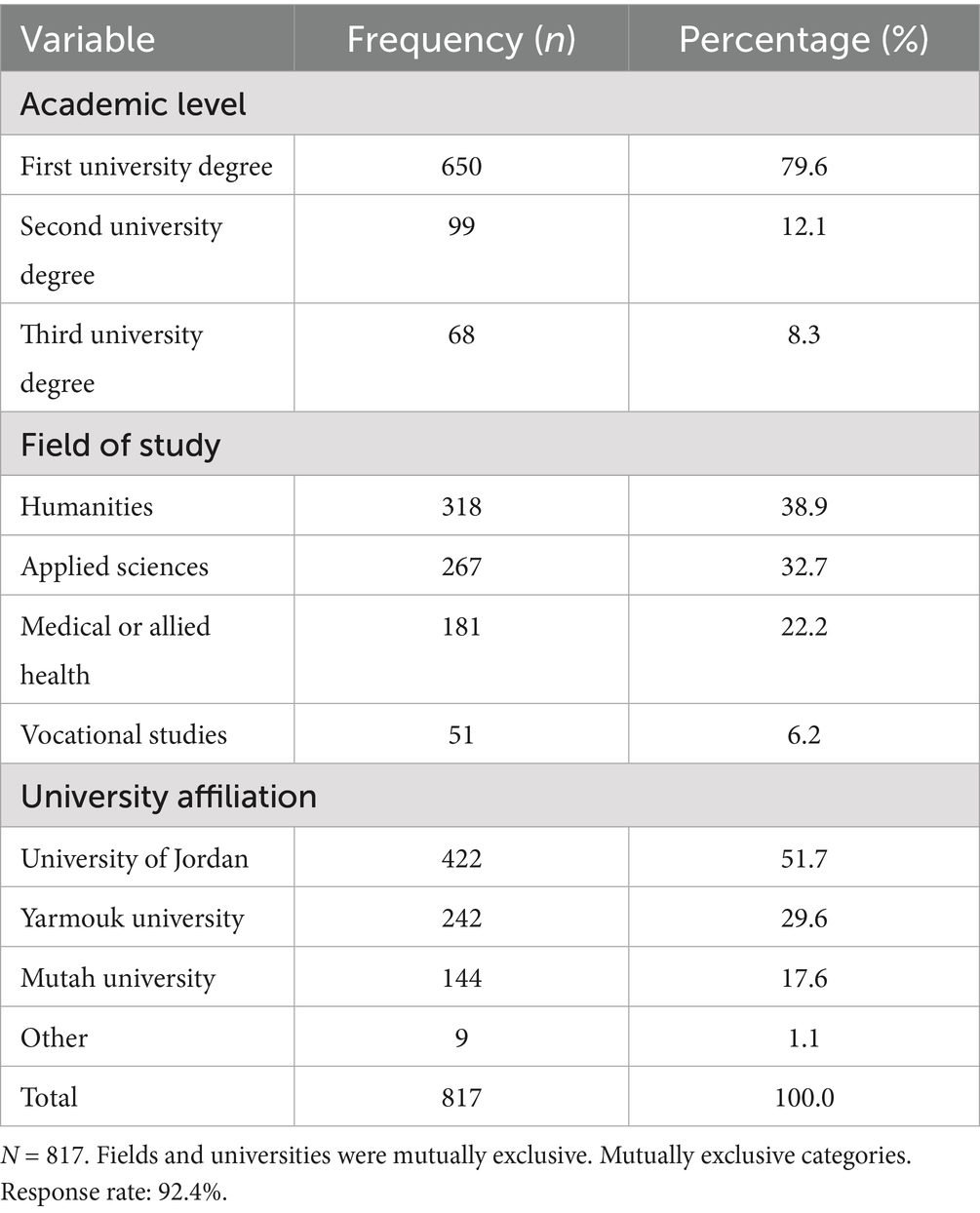
Table 2. Academic characteristics of participants, including degree level, field of study, and university affiliation.
4.2.2 Emerging contextual insight
Listening location data (Table 3) highlights patterns that foreshadow broader institutional constraints on media engagement. A significant majority of students (78.4%) reported listening to university radio during mobile or productive activities, with 40.5% tuning in while commuting by car and 37.9% while at the workplace. In contrast, only 18.2% reported listening at home, suggesting that passive or leisure-based consumption is limited and that radio engagement is largely integrated into students’ daily routines and functional environments.
4.2.3 Preparatory integration narrative
These contextual findings establish several foundational insights for interpreting the study’s results. First, the sample is largely representative of young, urban, early-career university students, as evidenced by the demographic distributions in Tables 1, 2. Second, listening patterns indicate high engagement during transitional or productive activities, such as commuting or working, rather than at-home leisure (Table 3). Third, a notable research tension emerges between students’ mobile-first listening preferences and the institutional limitations of traditional broadcast scheduling, suggesting potential misalignment. Finally, this gap underscores broader challenges in reconciling student expectations for online, flexible broadcasting with existing institutional capacities and infrastructure.
4.2.4 Quantitative findings
Student preferences for online broadcast scheduling revealed a near-even split, highlighting a critical dichotomy in listener expectations (Table 4). Half of the respondents (50.1%, n = 409) preferred live broadcasts restricted to peak hours, suggesting a demand for curated, time-bound programming aligned with daily routines. Conversely, 49.9% (n = 408) supported continuous 24/7 streaming, reflecting a desire for unrestricted access and on-demand flexibility. This divergence underscores a strategic challenge for university radio services in balancing structured content delivery with the growing expectation for digital immediacy.
4.3 Content preferences: audience priorities vs. editorial mandates
4.3.1 Quantitative patterns
Content preferences among students emphasized engagement and relatability over formal or traditional programming formats (Table 5). Social programs were the most favored, selected by 25.7% (n = 210) of respondents, followed closely by music segments at 23.7% (n = 194). Artistic content also garnered considerable interest (16.0%, n = 131). In contrast, more formal or institutionally-driven content types ranked lowest, with political programming attracting only 11.4% of preferences and religious content just 2.0%, indicating a clear tilt toward entertainment and cultural relevance in student media consumption.
4.3.2 Broadcast scheduling alignment: a joint interpretation
The integration of quantitative and qualitative findings revealed both convergence and tension between student preferences and institutional broadcasting capacities. Quantitative data indicated that students were nearly evenly divided in their preferred broadcasting models: 50.1% supported limiting live university radio broadcasts to peak listening hours, while 49.9% preferred continuous 24/7 streaming (Table 4). This split aligns partially with operational constraints reported by university radio directors. Specifically, Director 1 noted that “automation after 4 p.m. is unavoidable,” highlighting that live broadcasting is typically confined to daytime hours due to staffing limitations. This reflects a partial convergence, as peak-hour streaming aligns with existing staff schedules.
However, the nearly equal demand for 24/7 live streaming presents a contradiction, as Director 3 emphasized, “there is no budget for night-shift staffing,” underscoring the institutional inability to accommodate this demand.
Additionally, student preferences for listening times support a complementary pattern. The most favored listening period was early morning (35.3%, Table 6), which corresponds to volunteer availability noted in the qualitative data Director 4 confirmed that “morning slots attract most volunteers.” This indicates a mutual reinforcement between student behavior and the operational design of university radio, enhancing the alignment between user engagement and institutional logistics.
4.4 Platform and delivery: innovation demand vs. operational constraints
4.4.1 Quantitative findings
Students demonstrated a strong preference for digital-native content consumption. Notably, 60% favored short-form programming under 15 min in length (Table 7), reflecting the dominance of brief, easily digestible content. In terms of platform preference, TikTok emerged as the leading medium, with 41.9% of students favoring it over more traditional platforms such as Facebook (17.9%) and YouTube (3.2%) (Table 8), indicating a significant shift toward mobile-first, algorithm-driven media engagement.
4.5 Academic content balance: tolerance thresholds
4.5.1 Quantitative patterns
Academic content preferences revealed a clear “sweet spot” in terms of optimal content proportion. Specifically, 44.7% of students preferred academic content to comprise between 20% and just under 30% of total programming (n = 365), suggesting a balanced integration of educational material. In contrast, both lower (<20, 26.8%) and higher (>30, 25.6%) proportions were comparatively less favored, indicating resistance to content extremes (Table 9).
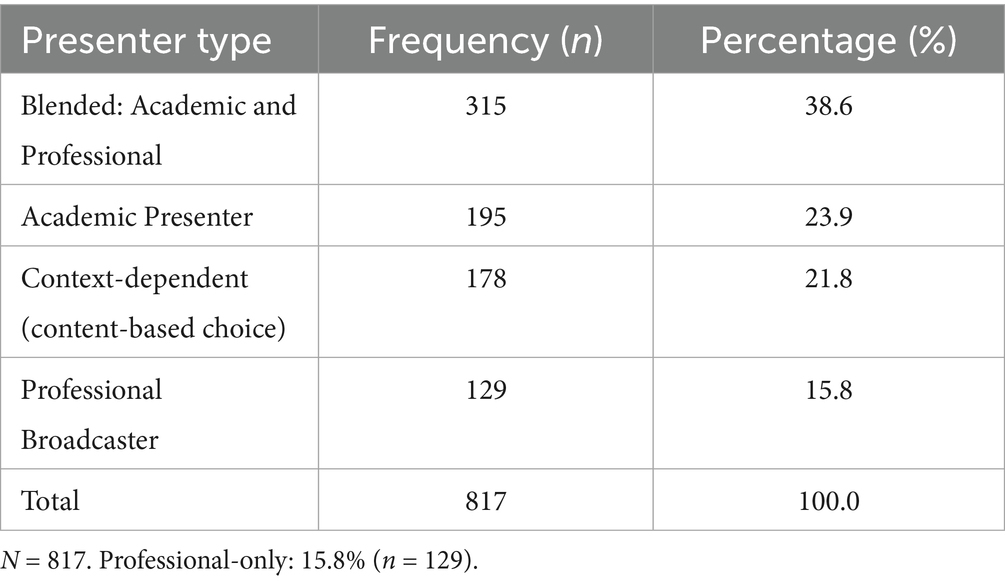
Table 9. Student preferences for the proportion of academic/educational content in overall programming.
4.6 Presenter preferences: evolving professional norms
Findings on presenter characteristics highlighted two key dynamics: expertise and gender. Regarding presenter expertise, 38.6% of students favored a hybrid model that combined academic and professional backgrounds, underscoring the appeal of blended credibility (Table 10). Additionally, 21.8% expressed a preference for presenters whose background matched the specific content, reflecting a pragmatic approach to contextual relevance. In terms of gender dynamics, competence emerged as the central criterion, with 28.2% of respondents prioritizing skill irrespective of gender. Nevertheless, gender-based preferences were present, as 29.3% favored male presenters while 21.2% preferred female presenters, indicating fluid but slightly male-leaning tendencies in perceived presenter effectiveness (Table 11).
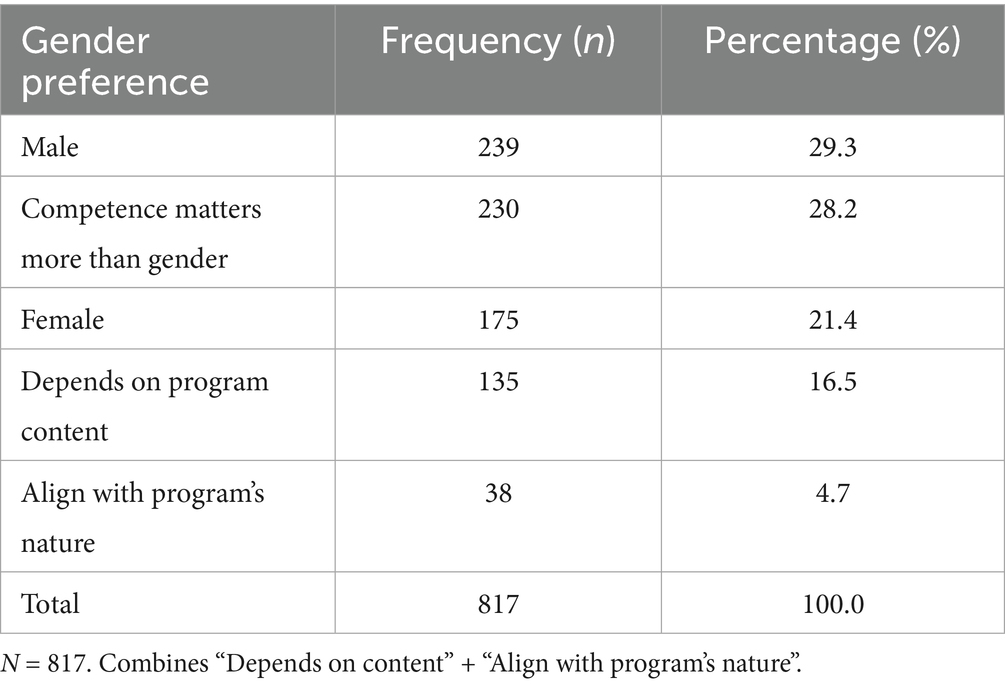
Table 10. Student preferences for presenter expertise (academic, professional, or blended backgrounds).
4.7 Listening patterns: behavioral realities
Quantitative data on preferred listening times revealed notable temporal patterns. The most popular time slot was early morning before 10 a.m., favored by 35.3% of students, aligning with typical commuter routines (Table 6). Additionally, 13.6% of respondents preferred listening after classes, indicating a degree of alignment with institutional schedules and radio director availability. These findings suggest that strategic scheduling could enhance engagement by catering to students’ daily rhythms and academic commitments.
4.7.1 Delivery and presentation alignment: a joint interpretation
The integration of student preferences and institutional perspectives regarding delivery formats and presenter profiles revealed areas of convergence, contradiction, and divergence. Quantitative results indicated that a majority of students (60%) preferred university radio programs under 15 min in length (Table 7), reflecting a broader trend favoring brevity and immediacy in digital media consumption. However, this preference diverged from institutional priorities. As Director 3 noted, “shorts compromise educational depth,” suggesting a tension between pedagogical goals and students’ reduced attention spans driven by platform norms such as TikTok.
In terms of dissemination platforms, students overwhelmingly favored TikTok (41.9%; Table 8), yet Director 2 stated, “FM broadcasting remains primary,” revealing a contradiction between student engagement on digital channels and the continued reliance on analog broadcast infrastructure within universities. This reflects a structural lag in adapting to digital-first communication preferences.
Conversely, alignment emerged in presenter selection. A plurality of students (38.6%) preferred a blend of professional broadcasters and academic presenters (Table 10), which converged with institutional practice; as Director 3 explained, “we hire credentialed entertainers,” reflecting a shared commitment to hybrid expertise. Additionally, 28.2% of students emphasized that competence matters more than gender or background, which complemented Director 2’s assertion that “skills trump demographics in hiring.” This mutual meritocratic orientation highlights shared values around professionalism and content quality in university radio delivery.
4.8 Satisfaction with program content: expectations vs. implementation
4.8.1 Quantitative findings
Students reported high overall satisfaction with university radio services, with a mean score of 3.78 (SD = 0.69) across 10 assessed dimensions (Table 12). Notable strengths included the diversity of programming (M = 4.17, SD = 1.37), the inclusion of heritage-focused content (M = 4.15, SD = 1.01), and the presence of expert-led discussions (M = 4.12, SD = 1.02). These results highlight the value students place on content variety, cultural relevance, and informed dialog in shaping a positive listening experience.
4.9 Subgroup differences
4.9.1 Gender and academic factors
Male students reported significantly higher levels of content engagement (M = 3.41, SD = 1.73) compared to their female counterparts (M = 2.95, SD = 1.69), as evidenced by an independent samples t-test, t (815) = 3.65, p < 0.001. The effect size, represented by Cohen’s d = 0.27, indicates a small to moderate difference, suggesting that gender may play a modest role in shaping patterns of engagement with university radio content.
4.9.2 Academic and residential variation
Analysis of quantitative patterns revealed mixed demographic effects on engagement. No significant differences were found across academic degree levels, F (2, 814) = 2.34, p = 0.097, with a negligible effect size (η2 = 0.006), suggesting that educational stage did not meaningfully influence content engagement. However, significant differences emerged based on students’ place of residence, as indicated by Welch’s F (3, 91.4) = 5.01, p = 0.003, η2 = 0.018. Post hoc comparisons showed that urban students (M = 3.21) reported significantly higher engagement than their Bedouin counterparts (M = 2.11; p = 0.002), highlighting a residential disparity in media access or receptivity.
4.9.3 Satisfaction and subgroup alignment: an integrated perspective
The mixed-methods synthesis of student subgroup responses and director narratives highlights both alignment and disconnects in satisfaction and engagement patterns. Quantitative analysis revealed that male students exhibited significantly higher engagement with university radio content than their female counterparts (Cohen’s d = 0.27, Table 13), yet Director 1 noted, “no gender-specific content” is currently produced. This reflects an omission in institutional practice namely, a lack of gender-targeted programming despite measurable variation in content engagement.
In contrast, the analysis found no significant differences in preferences across academic degree levels (η2 = 0.006, Table 14), supporting Director 2’s observation that “content transcends academic levels.” This convergence affirms that current programming strategies successfully appeal to students across undergraduate and graduate levels without requiring differentiated content streams (Table 15).
However, a significant difference in engagement was observed by place of residence, with urban students reporting higher engagement than those from Bedouin communities (p = 0.025, Table 16). Despite Director 3’s assertion that there are “equal broadcasts for all regions,” this points to a contradiction: universalistic claims may inadvertently obscure access disparities tied to geographic inequity, suggesting the need for more tailored outreach in underserved areas.
Finally, while the mean satisfaction with heritage-themed content was high (M = 4.15, Table 12), Director 3 acknowledged, “volunteers lack cultural expertise.” This reveals an implementation gap: although institutional messaging aligns with national identity goals, the actual delivery may fall short due to resources or capacity constraints. Bridging this gap would require more deliberate training and content development aligned with cultural preservation mandates (Table 17).
4.10 Academic specialization and residence: content engagement patterns
4.10.1 Academic specialization (hypothesis 3) quantitative findings
Analysis revealed no statistically significant differences in content engagement across academic fields, F (3, 813) = 2.14, p = 0.094, with a negligible effect size (η2 = 0.008). Although students from the Humanities reported a slightly higher mean engagement level (M = 3.12) compared to those in vocational programs (M = 2.89), this difference was not statistically meaningful, indicating that field of study had minimal impact on students’ engagement with university radio content.
4.10.2 Place of residence (hypothesis 4) quantitative evidence
Significant differences in content engagement emerged based on students’ residential background, as indicated by Welch’s F (3, 86.7) = 4.28, p = 0.007, with a small but meaningful effect size (η2 = 0.018). Urban students reported the highest engagement levels (M = 3.21, SD = 1.72), significantly surpassing those from Bedouin communities (M = 2.11, SD = 1.43; p = 0.003). Students residing in refugee camps demonstrated intermediate levels of engagement (M = 2.63), suggesting a gradient of access and receptivity influenced by geographic and infrastructural disparities.
4.11 University affiliation and age: homogeneous engagement
4.11.1 University affiliation (hypothesis 5) quantitative patterns
No significant institutional differences were observed in student engagement levels across the surveyed universities, F (3, 813) = 2.01, p = 0.111, with a negligible effect size (η2 = 0.007). Although students from the University of Jordan reported a slightly higher mean engagement (M = 3.08) compared to those from Mutah University (M = 2.97), this difference was not statistically significant, indicating that university affiliation did not meaningfully influence patterns of radio content engagement.
4.11.2 Age group (hypothesis 6): quantitative findings
No age-based differences in content engagement were detected, as indicated by F (3, 813) = 0.64, p = 0.589, with a minimal effect size (η2 = 0.002). Engagement levels remained consistent across age groups, with the 18–24 cohort reporting a mean of 3.01 and the 40 + group slightly higher at 3.12. These results suggest that age did not significantly influence students’ engagement with university radio content (Table 18).
4.11.3 Demographic engagement patterns and institutional responsiveness
The final integration matrix (Table 19) analyzes demographic subgroup patterns and their alignment with institutional interpretations. Quantitative results revealed no statistically significant differences in program preferences by academic specialization (η2 = 0.008), a finding affirmed by Director 4’s observation that “all fields engage equally.” This convergence supports the cross-disciplinary validity of the station’s content strategy, suggesting that a unified programming approach resonates broadly across academic domains.
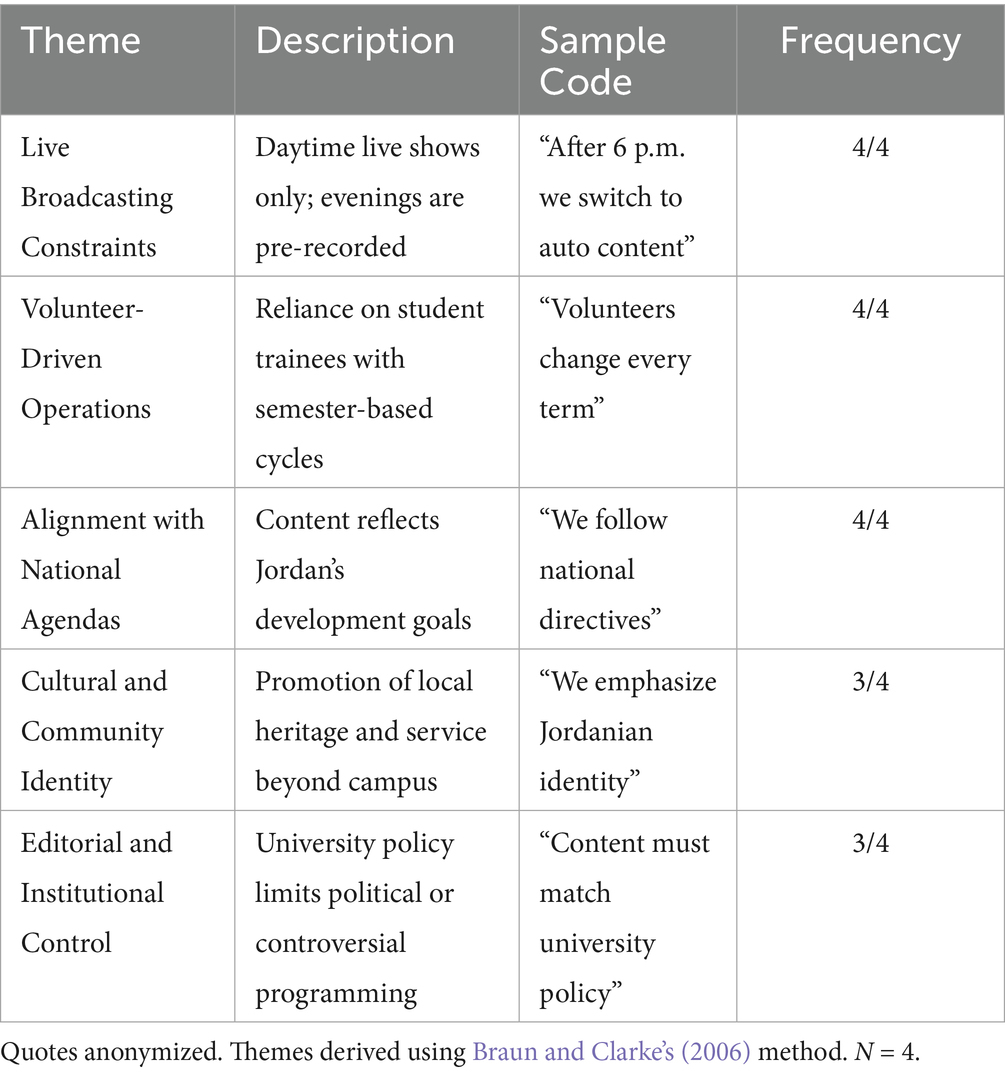
Table 19. Thematic summary of director interviews: key constraints, priorities, and institutional practices.
However, a significant engagement disparity was observed between urban and Bedouin students (p = 0.003, Table 16). While Director 1 attributed this to “spotty signals in Bedouin zones,” the disconnect highlights a contradiction between inclusion goals and infrastructural limitations. Such disparities underscore the need for targeted technical investments to enhance signal coverage and digital accessibility in marginalized regions.
No differences were found by university affiliation (p = 0.111), aligning with Director 2’s comment that “students want relatability, not prestige.” This complementarity reinforces the notion that a shared student culture across institutions enables standardization of content, obviating the need for university-specific programming.
Finally, age-based preferences also showed no significant variation (η2 = 0.002), which Director 3 contextualized by noting that “youth needs transcend age.” This explanatory alignment may reflect a developmental plateau wherein students across the 18–30 age range exhibit homogeneous media preferences, affirming the developmental coherence of the station’s youthful target audience.
4.12 Qualitative findings
4.12.1 Interview participant profiles
The qualitative component included semi-structured interviews with four directors of university radio stations in Jordan. All participants held senior administrative positions within their respective institutions and had over 5 years of experience in educational media. The directors represented geographically and institutionally diverse universities:
• Director 1: From a large central university, specializing in digital media innovation.
• Director 2: Affiliated with a northern university, with a background in journalism and youth programming.
• Director 3: Based in the south, emphasizing cultural heritage and community outreach.
• Director 4: Leading a regional station with a focus on student-led content and technical training.
To ensure anonymity, their names are withheld and pseudonyms (Director 1–4) are used throughout.
4.12.2 Theme 1: constraints on live broadcasting
All directors consistently emphasized that live broadcasting is confined to daytime hours, largely due to limitations in staffing and operational resources. Typically, programming concludes between 4:00 and 6:00 p.m., after which stations transition to automated or pre-recorded content. These constraints reflect both logistical and budgetary realities across institutions.
“Live transmission rarely extends beyond 4 PM due to operational limitations.” (Director 2)
“We rely heavily on recorded content in the evenings because we don’t have 24-hour staff.” (Director 1)
4.12.3 Theme 2: volunteer-based operational models
Closely related to the scheduling limitations is the operational reliance on student volunteers, a recurring theme across all interviews. Directors noted that recruitment and training efforts are typically concentrated at the beginning of each academic semester. However, program contributions vary significantly depending on the availability, interest, and competencies of student participants. This reliance introduces seasonal fluctuations in staffing and content quality.
“Programming relies on student volunteers. We hold open calls and train them competitively.” (Director 3) “There’s high turnover each semester brings a new cohort.” (Director 4)
4.12.4 Theme 3: alignment with National Development Priorities
Another dominant theme emerging from the interviews is the alignment of university radio content with national development agendas. Directors unanimously indicated that programming choices are informed by broader state priorities, including themes such as political participation, youth empowerment, and social inclusion. While political topics are addressed, they are generally limited to non-controversial, factual reporting or linked directly to official initiatives.
“We follow Royal directives when political pluralism was emphasized, we launched a program on political parties.” (Director 2) “Our station promotes the government’s agenda, including youth and marginalized voices.” (Director 1)
4.12.5 Theme 4: cultural identity and community orientation
Beyond institutional mandates, several directors emphasized the cultural and social mission of university radio. Specifically, three out of four directors underscored their stations’ roles in preserving Jordanian cultural identity and engaging audiences beyond university boundaries. This includes targeted outreach to rural and underserved communities and the promotion of Arabic language and heritage.
“We emphasize the Jordanian-Arab identity in all our segments.” (Director 3)
“The station is a social service, not just a student platform.” (Director 1)
4.12.6 Theme 5: editorial boundaries and institutional policy
Finally, directors acknowledged the constraints imposed by both university policies and national regulations on editorial freedom. These institutional frameworks delineate what can and cannot be broadcast, particularly concerning politically sensitive topics. As a result, programming must not only fulfill educational goals but also remain in alignment with overarching institutional and governmental expectations.
“We don’t touch on politics unless there’s a national directive.” (Director 2)
“There’s always a need to align with university policy, even if that means reducing political content.” (Director 4)
5 Discussion
This study reveals a fundamental tension in Jordanian university radio: while students overwhelmingly prefer accessible, entertainment-oriented content delivered through digital platforms, institutional operations remain constrained by resource limitations, state mandates, and infrastructural inequities. Students prioritized social (25.7%), music (23.7%), and artistic programs (16.0%), forming a clear preference cluster around culturally engaging formats. This stands in stark contrast to directors’ emphasis on state-aligned political and heritage content, highlighting a core misalignment between audience desires and institutional priorities. The divergence becomes particularly evident in broadcasting schedules, where nearly half of students (49.9%) expressed demand for 24/7 streaming a expectation directly contradicted by stations’ operational cutoff at 4–6 p.m. due to staffing shortages.
Further complicating this landscape is the digital innovation gap. Students demonstrated strong preference for platform-native consumption, with 60% favoring programs under 15 min and 41.9% selecting TikTok as their preferred delivery channel. Yet stations persisted in prioritizing FM broadcasting and long-form educational segments, reflecting what (Reelfs et al.’s, 2022). Media Ecology framework identifies as institutional inertia within evolving communication ecosystems. This technological generational divide illustrates how digital-native audiences inhabit a “TikTok ecosystem” demanding micro-content mobility, while universities remain anchored in analog-era workflows. The Uses and Gratifications perspective (Ayyad, 2011) further clarifies this tension: student preferences for social and music content fulfill identity reinforcement and entertainment needs, whereas state-mandated programming serves institutional surveillance functions a misalignment that inherently undermines engagement.
Notably, students expressed strong satisfaction with programming diversity and heritage-related content, although qualitative data revealed that these ratings often reflected institutional alignment rather than execution quality. Qualitative insights revealed these ratings reflected alignment with institutional missions rather than execution quality, as volunteer-driven production limited content sophistication. At the same time, structural inequities emerged geographically, as urban students reported higher engagement levels compared to their peers in Bedouin communities. This spatial marginalization (Petrova and Kislova, 2020) persists despite universal service claims, as infrastructural neglect in peripheral regions excludes non-urban communities from participatory media spheres. Paradoxically, preferences showed remarkable consistency across age, discipline, and institutional affiliation suggesting a shared digital-native orientation that cuts across traditional demographic categories.
These findings extend prior research in several directions. The preference for short-form content amplifies (Tufan et al., 2021) observed “entertainment shift” while challenging (Waisbord, 2018) focus on knowledge dissemination models. Similarly, the urban–rural engagement gap Similarly, the urban–rural engagement gap supports earlier critiques of infrastructure disparities in MENA media ecosystems (Suyanto et al., 2022). The observed gender difference in engagement, while modest, highlights a dimension that has been largely overlooked in regional research and therefore merits further investigation. Methodologically, the mixed-methods design enabled triangulation of scheduling contradictions through joint displays, while the nationally representative sample (N = 817) strengthened generalizability. However, the cross-sectional nature obscures longitudinal digital adoption trends, and the limited director sample (*n* = 4) restricted exploration of policy resistance dynamics so the findings should be interpreted as time-bound to 2024 rather than generalizable to long-term trends. Future research should therefore track how Gen Z’s platform migration reshapes radio’s pedagogical role and test hybrid presenter models in marginalized communities, while comparative studies could examine contrasts between Jordan’s state-aligned model and neighboring media systems.
The persistent disconnect between student agency and institutional logic ultimately positions university radio as an emerging site of contestation. Editorial boundaries may constrain youth-relevant discourse even as infrastructural gaps exclude peripheral communities, suggesting that fulfilling radio’s potential as a campus-community bridge requires reconciling its communal ethos with emerging digital realities.
In practical terms, universities could integrate TikTok into media training courses by developing structured student-led content labs. Under faculty supervision, students would design short-form videos that translate academic material (e.g., cultural heritage, scientific awareness, or civic engagement themes) into engaging formats tailored for TikTok. This approach not only provides students with hands-on production experience but also ensures that content aligns with institutional objectives and ethical guidelines, while still leveraging the platform’s participatory appeal.
6 Conclusion
This study investigated the role of digital platforms and content preferences in shaping student engagement with university radio in Jordan. Using a mixed-methods approach, it uncovered a significant mismatch between student expectations centered on short-form, entertainment-driven, mobile-accessible content and institutional programming constrained by limited resources and state mandates.
Findings highlight the urgency of updating university radio practices to reflect student media habits, particularly through digital integration and hybrid presenter models. While some content, like heritage programming, received high satisfaction ratings, qualitative data revealed execution gaps and regional access disparities, especially affecting Bedouin students.
By extending Media Ecology and Uses and Gratifications theories, the study contributes to understanding how institutional inertia and audience evolution intersect in regulated media contexts. Though limited by its institutional sample, the research offers a solid foundation for future studies on platform innovation, media governance, and student-led broadcasting in MENA.
Ultimately, bridging the gap between analog-era structures and digital-native audiences is key to realizing university radio’s potential as a platform for inclusive, student-driven civic discourse.
7 Recommendations
University radio stations in Jordan should adopt more student-centered content, prioritizing entertainment and social themes aligned with student preferences. Embracing digital platforms like TikTok and producing short-form content will enhance accessibility and engagement. Expanding broadcast hours and improving infrastructure, especially in underserved rural areas, can address participation gaps. Hybrid presenters combining subject expertise with relatability should be considered to balance academic goals with audience appeal. Finally, revising state-imposed programming constraints and incorporating student feedback mechanisms are essential steps toward creating more responsive and inclusive university media.
Data availability statement
The raw data supporting the conclusions of this article will be made available by the authors, without undue reservation.
Ethics statement
The study protocol was reviewed and approved by the Institutional Review Board (IRB) at Arab American University–Jenin. As the research involved minimal risk, informed consent was obtained electronically via Google Forms for surveys, where participants acknowledged agreement before proceeding, and through signed forms for director interviews. The study complies with the ethical principles outlined in the Declaration of Helsinki and adheres to national and institutional regulations governing research ethics in Palestine.
Author contributions
MK: Conceptualization, Investigation, Methodology, Project administration, Resources, Supervision, Validation, Writing – original draft, Writing – review & editing. MA: Data curation, Formal analysis, Software, Visualization, Writing – original draft.
Funding
The author(s) declare that no financial support was received for the research and/or publication of this article.
Acknowledgments
The authors gratefully acknowledge the support of their home institution, for providing the academic environment and resources necessary to carry out this research.
Conflict of interest
The authors declare that the research was conducted in the absence of any commercial or financial relationships that could be construed as a potential conflict of interest.
Generative AI statement
The authors declare that no Gen AI was used in the creation of this manuscript.
Any alternative text (alt text) provided alongside figures in this article has been generated by Frontiers with the support of artificial intelligence and reasonable efforts have been made to ensure accuracy, including review by the authors wherever possible. If you identify any issues, please contact us.
Publisher’s note
All claims expressed in this article are solely those of the authors and do not necessarily represent those of their affiliated organizations, or those of the publisher, the editors and the reviewers. Any product that may be evaluated in this article, or claim that may be made by its manufacturer, is not guaranteed or endorsed by the publisher.
References
Acheme, R. O., and Adesemoye, S. A. (2022). Perception and acceptance of campus radio (LASPOTECH 101.9 FM) among mass communication students of Lagos state polytechnic. Int. J. Soc. Sci. Manag. Rev. 5, 356–375. doi: 10.37602/IJSSMR.2022.5124
Al Subaihi, S. S., and Sawalha, I. H. (2023). Online news use habits of University of Jordan students. Dirasat Hum. Soc. Sci. 50, 365–375. doi: 10.35516/hum.v50i5.1300
Awiti, F., and Ong’ong’a, O. (2024). Audience perceptions on online radio platforms: a case of university students in Nyanza region, Kenya. Afr. J. Empir. Res. 5, 1011–1026. doi: 10.51867/ajernet.5.4.84
Ayyad, K. (2011). Internet usage vs. traditional media usage among university students in the United Arab Emirates. J. Arab Muslim Media Res. 4, 41–61. doi: 10.1386/jammr.4.1.41_1
Braun, V., and Clarke, V. (2006). Using thematic analysis in psychology. Qual. Res. Psychol. 3, 77–101. doi: 10.1191/1478088706qp063oa
Cerdá Suárez, L. M., Núñez-Valdés, K., and Quirós y Alpera, S. (2021). A systemic perspective for understanding digital transformation in higher education: overview and subregional context in Latin America as evidence. Sustainability 13:12956. doi: 10.3390/su132312956
Damani, K., and Mitchell, J. (2020). Radio: rapid evidence review (EdTech hub rapid evidence review). EdTech Hub.
Farah, N. A. (2020). Audience motivations in Arab university radio: a case study. Mid. East J. Commun. Stud. 12, 23–40. doi: 10.21834/mejcs.v12i1.55
Fetters, M. D., Curry, L. A., and Creswell, J. W. (2013). Achieving integration in mixed methods designs—principles and practices. Health Serv. Res. 48, 2134–2156. doi: 10.1111/1475-6773.12117
Habermas, J. (1989). The structural transformation of the public sphere: An inquiry into a category of bourgeois society. Cambridge, MA: MIT Press.
Miller, K. J. (2017). Educational engagement: College radio, digital media, and organizational change. PhD Dissertation, University of Iowa.
Mohd, R. M., and Puche, J. S. (2025). News repertoires in Jordan: navigating technological advancements and shifting audience dynamics. Dirasat Hum. Soc. Sci. 52:6920. doi: 10.35516/hum.v52i4.6920
Mostefaoui, A. (2019). Integrating podcasts and social media into Algerian radio. J. Radio Stud. 26, 112–129. doi: 10.1080/19376529.2019.1661462
Muringa, T., and Adjin-Tettey, T. D. (2024). Media literacy’s role in democratic engagement and societal transformation among university students. Afr. J. Stud. 45, 115–134. doi: 10.1080/23743670.2024.2424902
Omar, B., and Wang, D. (2020). Watch, share or create: the influence of personality traits and user motivation on TikTok mobile video usage. Int. J. Interact. Mob. Technol. 14, 121–137. doi: 10.3991/ijim.v14i04.12429
Petrova, E., and Kislova, O. (2020). Satellite and internet broadcasting: impact on radio reach. Glob. Media J. 18, 98–114. doi: 10.5784/18-3-2020-07
Reelfs, J. H., Hohlfeld, O., and Henckell, N. (2022). Differences in social media usage exist between Western and Middle East countries. arXiv 2022:697. doi: 10.48550/arXiv.2203.12697
Richardson, J. T. E. (2011). Eta squared and partial eta squared as measures of effect size in educational research. Educ. Res. Rev. 6, 135–147. doi: 10.1016/j.edurev.2010.12.001
Safar, A., and Alkhezzi, F. (2016). Students’ perspectives of the impact of online streaming media on teaching and learning at Kuwait University. Eur J. Math. Sci. Technol. Educ. 12, 2975–2989. doi: 10.12973/eurasia.2016.02317a
Suyanto, S., Latifah, K., and Muchid, M. (2022). Transformation of radio technology in the digital age. Nyimak J. Commun. 6, 115–130. doi: 10.31000/nyimak.v6i1.5547
Tick, A., and Lin, W. (2025). Transforming learning: digital platforms and their effect on student engagement and learning outcomes. Pract. Theory Syst. Educ. 20, 1–24. doi: 10.63145/ptse.v20i1.50
Tufan, F., Kökat, S., and Bal, Z. E. (2021). Content structure of university radio stations in Turkey. Connectist 61, 213–240. doi: 10.26650/CONNECTIST2021-907123
Usman, N. (2020). Issues and challenges of managing campus radio: a study of ABU Samaru FM radio station. Online J. Arts Manag. Soc. Sci. 8, 931–947. Available online at: https://www.academia.edu/92958905 (Accessed July 6, 2025).
Villaester, M. J. M. (2025). Reviving the traditional campus radio in the digital age: challenges and lessons from DYUP Sugbo. Int. J. Educ. Media Technol. 18:348. Available online at: https://ijemt.org/index.php/journal/article/view/348
Waisbord, S. (2018). The elective affinity between post-truth communication and populist politics. Commun. Res. Pract. 4, 17–34. doi: 10.1080/22041451.2018.1428928
Wang, X., and Wu, D. (2019). “Understanding user engagement mechanisms on a live streaming platform.” In Proceedings of the e-Commerce and Streaming Media Conference. Available online at: https://www.researchgate.net/publication/335519112.
Keywords: FM to TikTok, mixed-methods, platform gaps, content misalignment, rural–urban divides, university radio engagement
Citation: Khlouf MMM and Azmoty MN (2025) From FM to TikTok: a mixed-methods study of platform gaps, content misalignment, and rural–urban divides in Jordanian university radio engagement. Front. Commun. 10:1678387. doi: 10.3389/fcomm.2025.1678387
Edited by:
Ganiu Oladega Okunnu, Lagos State University, NigeriaReviewed by:
Margubur Rahaman, All India Institute of Medical Sciences Gorakhpur, IndiaAsem Kreishan, Cairo University Faculty of Mass Communication, Egypt
Copyright © 2025 Khlouf and Azmoty. This is an open-access article distributed under the terms of the Creative Commons Attribution License (CC BY). The use, distribution or reproduction in other forums is permitted, provided the original author(s) and the copyright owner(s) are credited and that the original publication in this journal is cited, in accordance with accepted academic practice. No use, distribution or reproduction is permitted which does not comply with these terms.
*Correspondence: Mahmoud Mohammad Mustafa Khlouf, TWFobW91ZC5raGxvdWZAYWF1cC5lZHU=
†ORCID: Mahmoud Mohammad Mustafa Khlouf, https://orcid.org/0000-0001-7929-7043
Mohammad Najeeb Azmoty, https://orcid.org/0009-0000-7015-4046
 Mahmoud Mohammad Mustafa Khlouf
Mahmoud Mohammad Mustafa Khlouf Mohammad Najeeb Azmoty2†
Mohammad Najeeb Azmoty2†